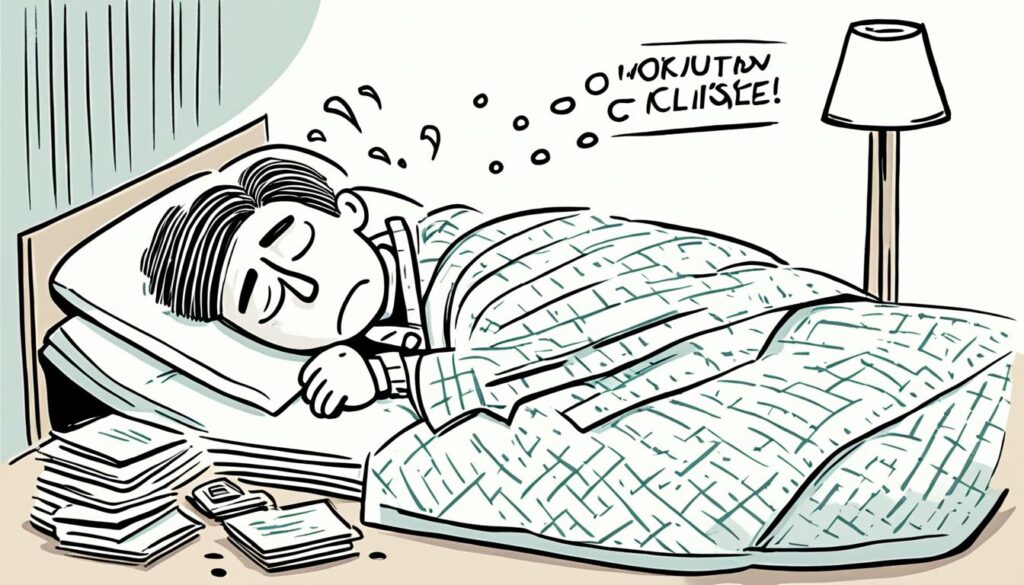Narcolepsy is a lifelong challenge. It directly affects how our brains manage when we sleep or are awake. People with often feel tired, even after a full night’s sleep. They may also have trouble staying awake during the day. This sickness makes it hard for them to stay alert, even while doing things they love.
The effects of go beyond just feeling sleepy. Sudden muscle weakness, vivid dreams or images during sleep, and even feeling paralyzed as they fall asleep or wake up can happen. This can be quite scary for those experiencing it. Yet, it is important to know that doesn’t get worse with time. In fact, some of its symptoms can get better as one grows older. However, the condition itself does not go away entirely. Managing requires lifelong care and attention.
Table of Contents
ToggleUnderstanding Narcolepsy: A Chronic Neurological Disorder
Narcolepsy is a long-term issue with the brain’s central system. It doesn’t create enough of a chemical for nerve communication. This problem can change someone’s daily routine a lot. It often causes extreme sleepiness during the day and other tough symptoms.
Excessive Daytime Sleepiness: The Hallmark Symptom
A central sign of narcolepsy is feeling very tired throughout the day. Even if they wake up feeling refreshed, fatigue hits them hard. They might have sudden bouts of sleepiness, known as “sleep attacks.” These can happen no matter how much they’ve slept.
But, during tasks that need focus, like work, their alertness might be normal. This makes handling daily life quite challenging for many with narcolepsy.
Other Symptoms: Cataplexy, Sleep Paralysis, and Hallucinations
Besides feeling very tired, narcolepsy might bring about other tough symptoms. Cataplexy, for example, makes muscles suddenly weak when someone feels strong emotions. Then there’s sleep paralysis. It locks you in place, unable to move or talk, either when waking up or falling asleep.
And let’s not forget about the vivid dreams. They can be so clear, they seem real, and sometimes really scary. These occur when moving from being awake to falling asleep.

It’s key to know the wide range of symptoms of narcolepsy. This knowledge helps in both recognizing and treating the disorder. With understanding and cooperation, patients and healthcare pros can create a plan that fits their needs.
The Two Major Types of Narcolepsy
Narcolepsy is a complicated condition that affects people in different ways. Understanding the types is key. There are two main types of narcolepsy – Type 1 and Type 2. They come with their own characteristics and effects.
Type 1 Narcolepsy: Cataplexy and Low Hypocretin Levels
Type 1 narcolepsy is also known as narcolepsy with cataplexy. It’s marked by low levels of a brain hormone called hypocretin. Or, it shows itself through cataplexy, which is a sudden loss of muscle control. Those with Type 1 often feel very sleepy during the day. They may have very low hypocretin levels. This is a chemical in the brain important for staying awake and REM sleep.
Type 2 Narcolepsy: Excessive Daytime Sleepiness without Cataplexy
Type 2 narcolepsy doesn’t include cataplexy. It’s mainly just extreme sleepiness during the day. This is different from Type 1, where emotions can trigger muscle weakness. People with Type 2 experience less severe symptoms.

Knowing the difference between Type 1 and Type 2 narcolepsy is crucial. It helps doctors diagnose and treat it properly. Since the causes and effects differ, this understanding is very important. It leads to better, more personalized care for those dealing with narcolepsy.
Autoimmune Disorders and the causes of narcolepsy
The cause of narcolepsy isn’t fully known, but research suggests it could be linked to different factors. When someone has cataplexy, it’s often because they’ve lost cells in their brain. These cells make a chemical called hypocretin, which helps keep us awake. It seems an autoimmune disorder, where the body attacks itself, might target these brain cells. This could happen because of a mix of genetics and the environment.
Autoimmune Attack on Hypocretin-Producing Neurons
In some families, you might find clusters of narcolepsy cases. Up to 10% of people with narcolepsy and cataplexy have a family member with alike symptoms. This suggests there’s a family link to narcolepsy. It shows a complex mix of genes and things around us might cause the immune system to attack hypocretin-making cells, causing narcolepsy.
The Role of Genetic and Environmental Factors
Studies have pinpointed various genetic and environment factors in narcolepsy causes. For example, a specific form of the HLA gene is in 98% of narcolepsy cases but only in 25% of the general population. Alongside genetics, things like infections seem to play a part. Cases increased during the 2009 H1N1 swine flu pandemic in China, suggesting a link.
The Genetic Link in Narcolepsy
The HLA system of genes helps control our immune system. It affects our risk for narcolepsy. A gene called HLA-DQB1*06:02, part of this family, is crucial. Those with it have a bigger chance of narcolepsy, especially with cataplexy.
This gene variation makes an immune attack on certain brain cells more likely. This can cause these brain cells to die.
The HLA Gene Complex and Immune System Regulation
Many people with narcolepsy have the HLA-DQB1*06:02 variation. And they often share similar versions of related genes.
However, this gene is not rare in the general population. Only a small group gets narcolepsy. This tells us that other factors also play a role.
The Significance of the HLA-DQB1*06:02 Variation
HLA-DQB1*06:02 is key in narcolepsy, especially with cataplexy. Changes in genes like the HLA-DQB1 gene and others are common in those with narcolepsy.
This highlights the significant role the HLA gene complex plays in explaining and treating narcolepsy. This underlines the importance of the HLA gene complex in understanding and treating narcolepsy.

Brain Injuries and Tumors: Rare Causes of Narcolepsy
Narcolepsy is mainly caused by issues with the immune system or by genes. But, it can also be caused by brain injuries or growths. These problems affect how our brain controls when we sleep and dream. This leads to narcolepsy’s key signs, like falling asleep a lot during the day.
These brain-related issues are rare. More often, narcolepsy comes from autoimmune diseases or genes. When the brain is hurt, its sleep-wake cycle gets messed up. This causes narcolepsy signs, such as feeling very tired during the day or suddenly losing muscle control.
Understanding these rare brain causes is vital. It’s something doctors and patients should know. Even if it’s not common, it’s important to recognize when such a cause might be there. This knowledge can lead to better care, no matter why someone has narcolepsy.

Narcolepsy: A Multifactorial Disorder
Narcolepsy seems to happen because of both our genes and things around us. It’s a blend of genetic traits and environmental causes. The main issue in type 1 narcolepsy is the loss of specific neurons in our brain’s hypothalamus.
This loss is linked to an auto-immune response. This auto-immune process starts after being affected by something in the environment. This happens mainly to those with certain genes.
The Interplay of Genetic and Environmental Factors
The ways genes and the environment mix to cause narcolepsy are still a puzzle. This mystery makes it hard to fully understand what leads to narcolepsy. Studies have found some genetic differences that might make some people more likely to get narcolepsy.
The HLA system is important. It helps control our immune system. It has a key role in who might get narcolepsy.
The Complexity of Narcolepsy Causation
The main problem in type 1 narcolepsy is the loss of certain neurons. But what starts this process isn’t fully known yet. Odd things like narcolepsy cases increasing after certain diseases, or in certain seasons, show that the environment might trigger it.
Patterns suggest that environmental factors could be crucial in understanding narcolepsy’s complex causes.
Demographic Factors and Narcolepsy
Narcolepsy can start in both children and adults. It often begins during childhood, the teenage years, or early adulthood. There are more cases among people aged 15 to 35. This condition affects both genders equally. Still, some studies show it might be a bit more common in males.
The reasons for these patterns are not completely clear. It could be linked to genetics, hormones, or the environment. These factors play a big role in the development of narcolepsy’s root causes.
Age of Onset: Peaks in Adolescence and Young Adulthood
Narcolepsy usually kicks in during childhood, the teen years, or early adult life. There are two main times when symptoms peak: at about age 15 and then again at 35. This shows there might be key biological or environmental triggers at these ages.
Gender Differences in Narcolepsy Prevalence
Studies suggest narcolepsy is slightly more common in males than in females. Why this happens is not fully understood. But, it’s likely due to a mix of hormones, genetics, and the environment. These factors shape how the disorder occurs and shows in different people.
The Impact of Narcolepsy on Daily Life
Narcolepsy can make life very challenging. It brings on extreme tiredness during the day and surprise sleep attacks. These can mess with your mind and mood, making it hard to focus or be happy. Also, sudden muscle weakness, or cataplexy, can be dangerous, especially when doing things like driving.
Impaired Cognitive and Psychological Function
Feeling very sleepy during the day is a major issue in narcolepsy. It can stop you from being alert when you need to be. This can mess with learning, remembering things, and making good choices. The sleep problems and ups and downs of narcolepsy can even lead to feeling down or anxious.
Increased Risk of Accidents and Injuries
Having narcolepsy means you’re more likely to get hurt or have an accident. Especially if what you’re doing needs focus and coordination. Sleepiness or muscle weakness can happen suddenly and be very risky, even life-threatening. But, proper treatment and care can help lower these dangers. This way, you can feel safer and more sure about your day.
FAQ
What is narcolepsy?
Narcolepsy is a long-lasting health issue affecting the brain. It makes it hard for people to control when they sleep and wake up. They might feel like they’ve just slept, then suddenly get very tired during the day. This can make them fall asleep without meaning to, even while doing something.
What are the symptoms of narcolepsy?
Narcolepsy has a few main signs. These include feeling very sleepy during the day, muscle weakness that comes on suddenly, seeing vivid things that aren’t really there, and a period of being unable to move right before sleep or right after waking.
What are the two major types of narcolepsy?
Doctors have split narcolepsy into two main types. Type 1 is when a person feels really sleepy during the day and can also have muscle weakness, especially when feeling strong emotions. It’s often linked to not having enough of a certain brain chemical. Type 2 narcolepsy is similar but doesn’t include the muscle weakness part.
What causes narcolepsy?
We’re not entirely sure what causes narcolepsy, but scientists think it’s probably a mix of genes and things in the world around us. In some cases, if a person has cataplexy, or muscle weakness tied to narcolepsy, it’s because their body attacks brain cells that help them stay awake. This happens because of a problem with their immune system.
How do genetics and the immune system play a role in narcolepsy?
Certain genes can make a person more likely to have narcolepsy, especially the type with muscle weakness. These genes make it easier for the body to mistakenly attack the brain cells that help us stay awake.
Can brain injuries or tumors cause narcolepsy?
In very rare cases, narcolepsy might be caused by injuries to the brain or by certain types of tumors. These can mess up how the brain controls sleeping and waking. As a result, narcolepsy symptoms might develop.
Who is affected by narcolepsy?
Narcolepsy can start in people of any age. But it usually begins when they’re young, between the teen years and early adulthood. It affects men and women about the same. But some studies think it might be a bit more common in men.
How does narcolepsy impact daily life?
Narcolepsy can really change how someone lives each day. It can make thinking hard and may cause emotional issues. Feeling super tired during the day and suddenly falling asleep can get in the way of school, work, and spending time with others. People with narcolepsy should be careful when doing things that need focus, like driving, to avoid accidents.
Source Links
- https://www.ninds.nih.gov/health-information/disorders/narcolepsy
- https://www.sleepfoundation.org/narcolepsy
- https://www.nhs.uk/conditions/narcolepsy/
- https://www.hopkinsmedicine.org/health/conditions-and-diseases/narcolepsy
- https://my.clevelandclinic.org/health/diseases/12147-narcolepsy
- https://www.healthline.com/health/narcolepsy
- https://www.nature.com/articles/nature.2013.14413
- https://www.ncbi.nlm.nih.gov/pmc/articles/PMC5773260/
- https://rarediseases.org/rare-diseases/narcolepsy/
- https://medlineplus.gov/genetics/condition/narcolepsy/
- https://www.ncbi.nlm.nih.gov/books/NBK22236/
- https://www.ncbi.nlm.nih.gov/pmc/articles/PMC6325123/
- https://www.ncbi.nlm.nih.gov/pmc/articles/PMC9688775/
- https://www.ncbi.nlm.nih.gov/books/NBK459236/
About The Author

This article is medically reviewed by Dr. Chandril Chugh, Board-Certified Neurologist, providing expert insights and reliable health information.
Dr. Chandril Chugh is a U.S.-trained neurologist with over a decade of experience. Known for his compassionate care, he specializes in treating neurological conditions such as migraines, epilepsy, and Parkinson’s disease. Dr. Chugh is highly regarded for his patient-centered approach and dedication to providing personalized care.
→ Book a consultation to discover which remedies suit your needs best.




